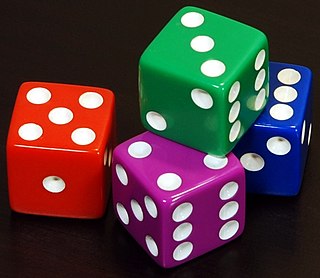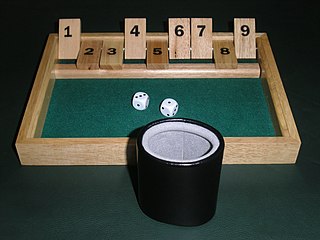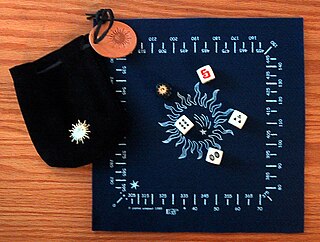
A die is a small, throwable object with marked sides that can rest in multiple positions. Dice are used for generating random values, commonly as part of tabletop games, including dice games, board games, role-playing games, and games of chance.

Shut the box is a game of dice for one or more players, commonly played in a group of two to four for stakes. Traditionally, a counting box is used with tiles numbered 1 to 9 where each can be covered with a hinged or sliding mechanism, though the game can be played with only a pair of dice, pen, and paper. Variations exist where the box has 10 or 12 tiles.
In statistics, gambler's ruin is the fact that a gambler playing a game with negative expected value will eventually go bankrupt, regardless of their betting system.

Three man is a drinking game played with two dice. It can be played with at least three people but some consider it better with around five.
In information theory, the information content, self-information, surprisal, or Shannon information is a basic quantity derived from the probability of a particular event occurring from a random variable. It can be thought of as an alternative way of expressing probability, much like odds or log-odds, but which has particular mathematical advantages in the setting of information theory.

Mia is a simple dice game with a strong emphasis on bluffing and detecting bluff related to Liar's dice.

Pig is a simple die game first described in print by John Scarne in 1945. Players take turns to roll a single die as many times as they wish, adding all roll results to a running total, but losing their gained score for the turn if they roll a .
Liar's dice is a class of dice games for two or more players requiring the ability to deceive and to detect an opponent's deception. In "single hand" liar's dice games, each player is given a set of dice, all players roll once, and the bids relate to the dice each player can see plus all the concealed dice. In "common hand" games, there is one set of dice which is passed from player to player. The bids relate to the dice as they are in front of the bidder after selected dice have been re-rolled. Originating during the 15th century, the game subsequently spread to Latin American and European countries. In 1993, a variant, Call My Bluff, won the Spiel des Jahres.

Cee-lo is a gambling game played with three six-sided dice. The name is derived from the Chinese name for the game, which is literally the numerical sequence four-five-six. Although many variations exist, there are certain common rules, including the use of three dice and common roll combinations, such as rolling a 4-5-6 to win, 1-2-3 to lose, and other combinations which establish a point for comparison to rolls by other player(s).

High Rollers is an American television game show created by Merrill Heatter. Two contestants compete to answer trivia questions and gain control of an oversized set of dice, which they then roll to eliminate the numbers 1 through 9 from a game board in order to win cash and prizes. It is an adaptation of the standard dice game shut the box.
A set of dice is intransitive if it contains X>2 dice, X1, X2, and X3... with the property that X1 rolls higher than X2 more than half the time, and X2 rolls higher than X3 etc... more than half the time, but where it is not true that X1 rolls higher than Xn more than half the time. In other words, a set of dice is intransitive if the binary relation – X rolls a higher number than Y more than half the time – on its elements is not transitive. More simply, X1 normally beats X2, X2 normally beats X3, but X1 does not normally beat Xn.

Cosmic Wimpout is a dice game produced by C3, Inc in 1976. It is similar to 1000/5000/10000, Farkle, Greed, Hot Dice, Squelch, Zilch, to name but a few. The game is played with five custom dice, and may use a combination score board and rolling surface, in the form of a piece of cloth or felt available in various colors and designs. Players supply their own game piece for score keeping.
Dice notation is a system to represent different combinations of dice in wargames and tabletop role-playing games using simple algebra-like notation such as d8+2.
In probability theory, the craps principle is a theorem about event probabilities under repeated iid trials. Let and denote two mutually exclusive events which might occur on a given trial. Then the probability that occurs before equals the conditional probability that occurs given that or occur on the next trial, which is
Chingona is a dice game played by two or more players, using four or five dice and a cup. It is usually played to decide who is to pay for the next round of drinks, but betting can also be involved.

Poker dice are dice which, instead of having number pips, have representations of playing cards upon them. Poker dice have six sides, one each of an Ace, King, Queen, Jack, 10, and 9, and are used to form a poker hand.

Ship, Captain, and Crew is a drinking game played with five dice. The game can be played with as few as two people but is usually played in a group of five or more. The object of the game is to roll a six, a five ("captain"), and a four ("crew") with three dice, and get the highest score with the other two dice. In other versions, a four is the "mate" and the remaining dice are the crew.
The mathematics of gambling is a collection of probability applications encountered in games of chance and can get included in game theory. From a mathematical point of view, the games of chance are experiments generating various types of aleatory events, and it is possible to calculate by using the properties of probability on a finite space of possibilities.
Horsengoggle is a method of selecting a random person from a group. Unlike some other methods, such as rock paper scissors, one of the features of horsengoggle is that there is always a winner; it is impossible to tie.
Bidou and the closely related Montevideo are dice games which are scored according to the combination of three rolled dice; each player rolls their set of three dice simultaneously, then checks their values while keeping them concealed from other player(s) beneath a cup. Each player then wagers into a common pot, based on their roll, before revealing the dice to the other player(s); players may bluff to hint or mislead others about the strength of their concealed roll, similar to the gameplay of poker.
















